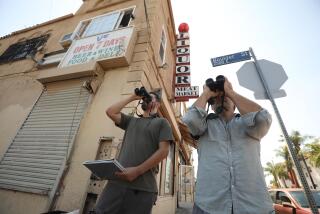Wildlife Returns to City as Pollution, Industry Decline
- Share via
LONDON — Less pollution, more garbage and the decline of heavy industry have brought wildlife to London.
Squirrels abound in the parks, perching on trash cans at Marble Arch to munch discarded sandwiches and lick candy papers.
Crows strut in Hyde Park, contesting for fast food remnants with the squirrels, pigeons, blackbirds and sparrows.
Salmon, migrating from the sea, were caught in the Thames this year, a tribute to two decades of pollution control.
“Foxes have moved in, rearing cubs on railroad embankments and in derelict basements and finding food in streets and back yards,” said Jeff Edwards, conservation officer at the London Wildlife Trust.
One of London’s glories is its parks and wild open spaces. It’s also a gardener’s city, in which almost every home has its green back yard.
Turning up in the unlikeliest inner city corners are the ubiquitous allotments, small patches of land distributed to retirees to raise vegetables and flowers. It’s a vestige of World War II, when the British were commanded to grow food on every possible square foot of their island.
Edwards said the 1956 Clean Air Act, prompted by killer smog, stopped coal fires being burned in homes, cleaned the air and improved the prospects for wildlife, although increased traffic cancels out some of the gains.
“Kestrels are nesting in high places and preying on sparrows where they used to eat small rodents in the country. Magpies were once seen only in the country but are nesting in trees in the streets and pinching the eggs of smaller birds, as well as scavenging.
“Wildlife can’t survive in bits of formal parkland--it needs wild places as well,” he said.
A prime example is Camley Street in King’s Cross, where volunteers cleared derelict land, dug ponds and then left nature to create a remarkable patch of the wild in the midst of one of the capital’s seediest districts.
“It is wonderful for children in the heart of London to see frogs, toads, newts and minnows a few yards from a busy street,” Edwards said.
But change has its price.
The Camley Street park is under threat from its landlord, British Rail, which needs room to expand.
More to Read
Sign up for Essential California
The most important California stories and recommendations in your inbox every morning.
You may occasionally receive promotional content from the Los Angeles Times.









